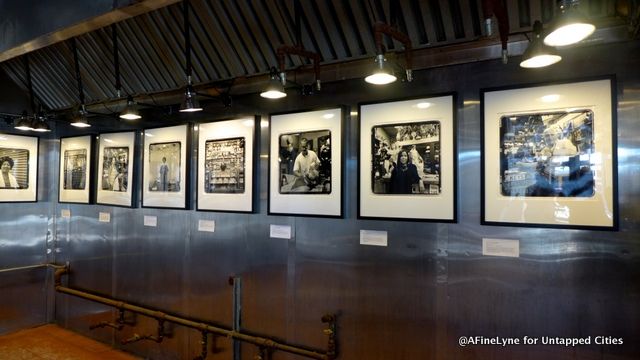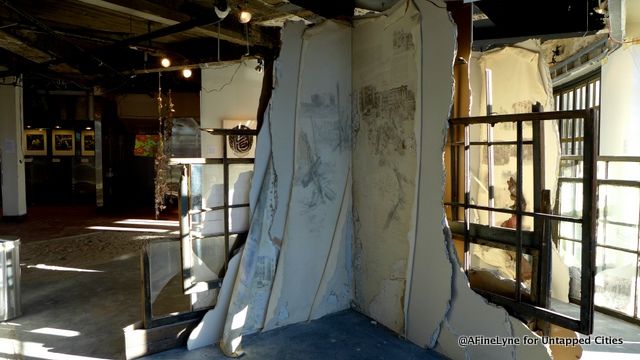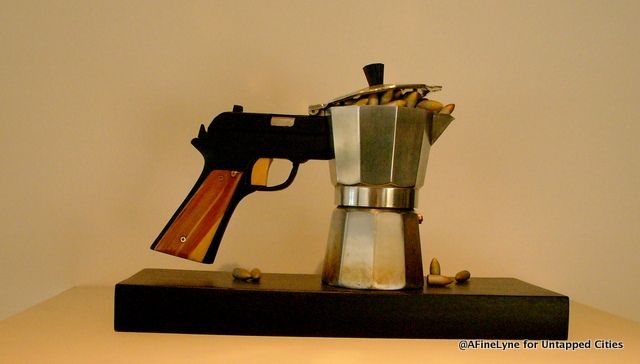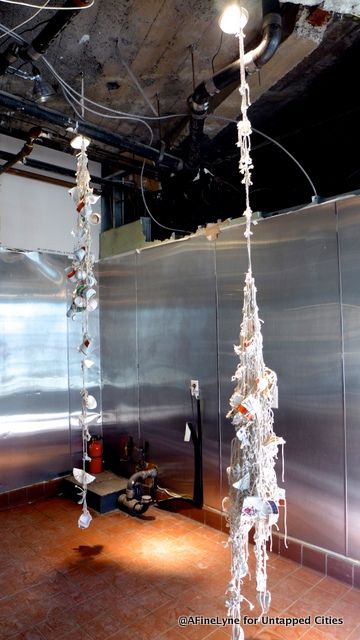NYC's Long-Awaited Davis Center Opens in Central Park
A stunning new facility at Harlem Meer opens to the public this weekend!


The No Longer Empty Curatorial Lab (NLE Lab) is addressing one of New York’s hot topics – community change – with its current exhibit NLE Lab: Intersecting Imaginaries. The subject matter, shown in visual form, explores the culture and current environment of the South Bronx, and at the same time, draws parallels with current changes going on throughout New York City. The exhibit addresses what happens when community connections are broken, and the many issues that affect the people who live there via site-specific works by a collection of artists.
The exhibit takes place in a gallery location on the Grand Concourse that was once The Concourse Plaza Hotel. It survived the burning of the Bronx and became a welfare hotel prior to being purchased by the city in 1973, when it became a home for the elderly. The raw ground-floor space on the corner, with its uneven floors and ceiling open to pipes and beams, helps to bring the artwork into context. In this group exhibit, the artists bring to life their individual identities and a changing community by mapping place, time and identity.
Below are a few of the many thoughtful pieces of artwork in Intersecting Imaginaries.

The collection of photographs above, by different artists, showcase the shops that make up this community, as well as the people who own them and the people who work there. Each portrait shares a personal story about where they came from, and what their hopes and dreams are for their future.

Miriam Maddi photographed by Rhynna Santos
Photographer Rhynna Santos brings to life Miriam Maddi who is an employee at the Botanica San Elias. Miriam was born in the Dominican Republic and came to the United States eight years ago. She’s been employed at the shop, located at 1326 Jerome Avenue, for the past five years. Her dream is to one day own a health spa.

Rebecca at the God Is Wonderful Hair Weave & Braiding Shop located at 2 West 183rd Street
Photographer Adi Talwar introduces us to Rebecca. Originally from Ghana, Rebecca works part-time at her sister’s hair weave and braiding shop. Both Rebecca and her husband are studying health care. She would like to become a doctor.

Mails Rodriguez behind the counter of the Valencia Bakery
Photographer Jonathan Santiago takes us to a familiar shop, the Valencia Bakery located at 1997 Jerome Avenue, and introduces us to Mails Rodriguez. Mails has worked at the bakery as a sales clerk and decorator for over ten years.

Linda Cunningham has been documenting the changing landscape of the Bronx for fifteen years. In her exhibit Surviving Then and Now: South Bronx Sagas (above and below), she uses found construction elements, collage, dry wall, canvas and photographs to convey her feeling of memory, loss and survival. She focuses on spaces where moisture invades architecture, and questions what remains and what is being destroyed.

Surviving Then and Now: South Bronx Sagas by Linda Cunningham
Coffee Break by Josue Guarionex addresses the transatlantic slave trade, in which slaves, crops and manufactured good were trafficked between European colonies, West Africa and the Caribbean. His work reveals our silent complicity in violence and connection to systems of oppression by mapping the history of Caribbean coffee and sugar. His piece interjects reality, and hopes to bring meaningful conversation into a symbol of a morning ritual, the coffee maker.

Down a short narrow hall, and into the restroom, you will find photography and a video by Elia Alba (below). Here the artist is paying homage to the underground dance culture that originated in the Bronx in the late 70s and early 80s in a celebration of sexuality and queer-culture of that time.

All masks photocopy transfers on muslin, fabric, thread and acrylic. Artist Elia Alba
Morir Matando (below) by Manuela Viera-Gallo is part of the series Domestic Violence. His tightly bound broken dishes are precariously hanging, evoking the troubling and pervasive reality of domestic violence. The thick, knotted robes represent the visceral sensation of aggression, while the broken porcelain represents the existence of women’s oppression and abuse.

Morir Matando by Manuela Viera-Gallo

Sky Above by Amy Pryor
Amy Pryor created a visual-verbal map of the thirty-nine constellations that are visible from this gallery during the months of November and December. This is her interpretation of the spatial coordinates that chart the existence and time through waste, and the blurring lines between commerce, culture and cosmos. Just left of the cosmos is an interactive wall and a way to “Continue the Conversation” with your thoughts. Always interesting to read what’s on the minds of those visiting the exhibit.

On the wall adjacent to the front door (below), you will find three architectural sketches created by the artist Giorgio Guidi. The Forum is a semi-permanent structure which will be built at the Andrew Freeman House, a few blocks north of this exhibit. Viewers are presented with these sketches and encouraged to pick up a pencil and vote for the design of their choice. The structure, which will be completed this December, will be used by the children who attend the Andrew Freedman House daycare and extracurricular activities.

Participate in “The Forum” by artist Giorgio Guidi
In conjunction with the exhibition, there will be a series of public programs. Intersecting Imaginaries will be on view through December 13, located at 900 Grand Concourse storefront. You can read more about the Bronx here, and 8 Architectural Gems along the Grand Concourse here. Get in touch with the author at AFineLyne.
Subscribe to our newsletter